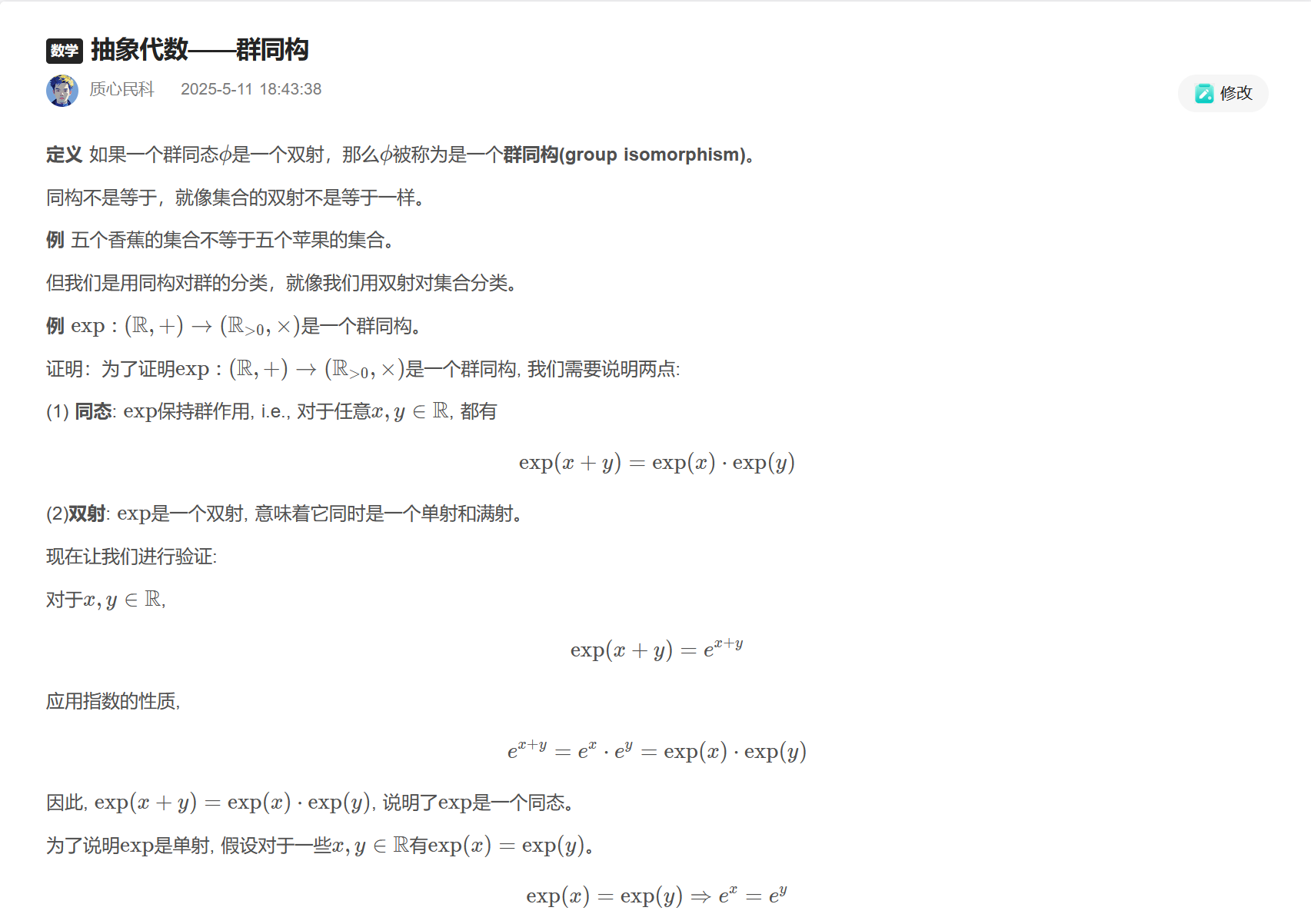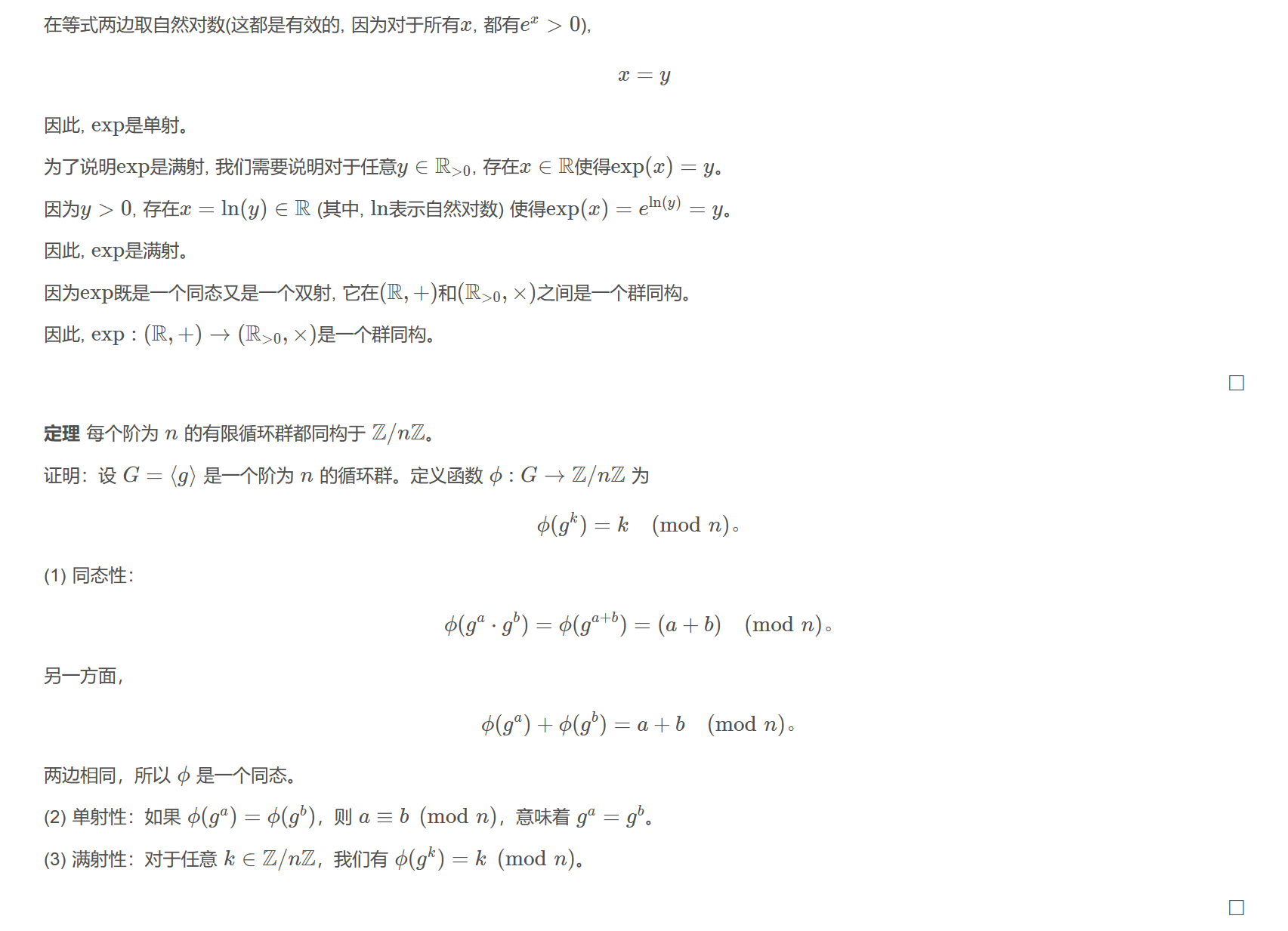数学 抽象代数——群同构
定义 如果一个群同态$\phi$是一个双射,那么$\phi$被称为是一个群同构(group isomorphism)。
同构不是等于,就像集合的双射不是等于一样。
例 五个香蕉的集合不等于五个苹果的集合。
但我们是用同构对群的分类,就像我们用双射对集合分类。
例 $\exp:(\mathbb{R},+)\to(\mathbb{R}_{>0},\times)$是一个群同构。
证明:为了证明$\exp: (\mathbb{R}, +) \to (\mathbb{R}_{>0}, \times)$是一个群同构, 我们需要说明两点:
(1) 同态: $\exp$保持群作用, i.e., 对于任意$x, y \in \mathbb{R}$, 都有$$\exp(x + y) = \exp(x) \cdot \exp(y)$$
(2)双射: $\exp$是一个双射, 意味着它同时是一个单射和满射。
现在让我们进行验证:
对于$x, y \in \mathbb{R}$,$$\exp(x + y) = e^{x+y}$$应用指数的性质,$$e^{x+y} = e^x \cdot e^y = \exp(x) \cdot \exp(y)$$因此, $\exp(x+y) = \exp(x) \cdot \exp(y)$, 说明了$\exp$是一个同态。
为了说明$\exp$是单射, 假设对于一些$x, y \in \mathbb{R}$有$\exp(x) = \exp(y)$。$$\exp(x) = \exp(y) \Rightarrow e^x = e^y$$在等式两边取自然对数(这都是有效的, 因为对于所有$x$, 都有$e^x > 0$),$$x = y$$
因此, $\exp$是单射。
为了说明$\exp$是满射, 我们需要说明对于任意$y \in \mathbb{R}_{>0}$, 存在$x \in \mathbb{R}$使得$\exp(x) = y$。
因为$y > 0$, 存在$x = \ln(y) \in \mathbb{R}$ (其中, $\ln$表示自然对数) 使得$\exp(x) = e^{\ln(y)} = y$。
因此, $\exp$是满射。
因为$\exp$既是一个同态又是一个双射, 它在$(\mathbb{R}, +)$和$(\mathbb{R}_{>0}, \times)$之间是一个群同构。
因此, $\exp: (\mathbb{R}, +) \to (\mathbb{R}_{>0}, \times)$是一个群同构。
$$~\tag*{$\square$}$$
定理 每个阶为 $n$ 的有限循环群都同构于 $\mathbb{Z}/n\mathbb{Z}$。
证明:设 $G=\langle g\rangle$ 是一个阶为 $n$ 的循环群。定义函数 $\phi: G \to \mathbb{Z}/n\mathbb{Z}$ 为$$\phi(g^{k})=k \pmod n。$$(1) 同态性:$$\phi(g^{a}\cdot g^{b})=\phi(g^{a+b})=(a+b) \pmod n。$$另一方面,$$\phi(g^{a})+\phi(g^{b})=a+b \pmod n。$$两边相同,所以 $\phi$ 是一个同态。
(2) 单射性:如果 $\phi(g^{a})=\phi(g^{b})$,则 $a\equiv b \pmod n$,意味着 $g^{a}=g^{b}$。
(3) 满射性:对于任意 $k\in\mathbb{Z}/n\mathbb{Z}$,我们有 $\phi(g^{k})=k \pmod n$。$$~\tag*{$\square$}$$
§3.2.3 群同构的性质
命题 如果$\phi:G\to H$是一个群同构, $\phi^{-1}$是一个群同构。
证明: 很明显, 它是一个双射。需要证明$\phi^{-1}$是一个同态: $\forall g_{1},g_{2}\in G$, $h_{1}=\phi(g_{1}),h_{2}=\phi(g_{2})$, 我们有
$$\begin{aligned}\phi^{-1}(h_{1}\cdot h_{2})&=\phi^{-1}(\phi(g_{1})\cdot\phi(g_{2}))\\&=\phi^{-1}(\phi(g_{1}\cdot g_{2}))\\&=(\phi^{-1}\circ\phi)(g_{1}\cdot g_{2})\\&=g_{1}\cdot g_{2}\\&=\phi^{-1}(h_{1})\cdot \phi^{-1}(h_{2})\end{aligned}$$
$$~\tag*{$\square$}$$
板砖特供版:



